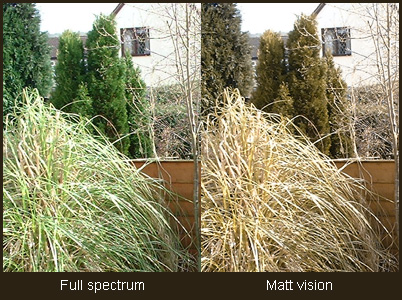Writing Blind for Those Who Can See
As a colour-blind person, the nature of colour has never been something of particular importance to me, unless it serves a challenge – unfortunately, as with other conditions, the challenges are imperceptible to those around you. I’m not saying that I am comparable to a paraplegic or those completely without sight, but there are certain things that are ever so slightly tainted as a direct result.
My nan and her sister (and parents) were all talented artists in their own way. Granny, as she prefers to be known, would tell me how she and her sister would argue over the name of a shade of purple for example. ‘No, it’s mauve.’ ‘Don’t be ridiculous, it’s lilac.’ This baffled me as a child who had never - and still hasn’t - witnessed the colour purple in it’s true form.
I have ‘deuteranopia’ or by it’s common name ‘red-green colour-blindness’. I’ve never been completely sure whether colour-blindness is a spectrum or a ‘you have it or you don’t’ kind of condition. I suppose this is hard to tell when you have unreliable participants for studies. How can you compare perception? Either way, mine is significant enough that when I show people what I can see, there is an immediate sympathetic response. It’s not what I’m after, I’m just helping them to understand. (See picture – if I’m allowed to post it).
The first real challenge this (disability?) gave me was drawing. One particular event has stuck with me since it happened. I was probably five or six. We were learning about the Victorians at school and part of our lesson consisted of us drawing what we thought the Victorians looked like. I wasn’t bad at the sketching part, though I doubt it would have made it onto the fridge! It was the colouring that tested me, so I sought help. I asked my best friend, Dan, to pass me the pencils I needed. Blue for the sky – I drew the strip of blue for the sky, leaving the middle white, of course. Why would there be sky behind people? Then I asked for brown for their clothes. I coloured in their rags, complete with holes to show their hard, poverty-stricken lives. A bit of green for the grass.
Then he started laughing.
‘What?’ I asked, but he didn’t tell me.
More laughs from a few others. What was it? Their hands weren’t particularly well formed, but they definitely weren’t the worst effort in the class.
‘Why do you think they all wore green?’ asked my teacher. ‘And why is the sky purple?’
I just shrugged.
Red and green are not the only colours affected, though they do play an important part. I can’t tell the difference between blue and purple due to the red element, brown and green are the same depending on tone, orange and yellow, red and brown, pink and grey (which can be odd sometimes – I once thought I saw a pink poodle but was swiftly corrected).
People ask me how I know when to stop for traffic lights and I joke that I know the red light’s at the top and the green’s at the bottom. This isn’t the case. Bright tones such as these I can tell the difference between. Murky tones are the hardest to distinguish and this becomes easier as they get brighter, traffic lights are no problem at all.
And this brings me to writing – sorry it took so long…
I’ve not been writing for a long time, less than two years, but one of the things that challenges me the most is description of colour. I can have a vivid picture in my mind of what I would see, but not what the majority of my readers would see. How do I know if I’m describing the colours, the tones correctly? I find myself searching my memory for words used in other books or on TV or by Granny. If they’ve said it, it must be right. But I want to make it my own, so I twist and change the colours to fit in with my imagination, and of what I think colours should look like if it weren’t for my useless retinal cones. I hope others see what I want them to see, not a poor translation of my dulled version of reality.
I’ve come to realise, recently, that it doesn’t matter too much. Perhaps, in fact, I should think of it as a novelty for my readers and, in my second WIP, I’ve even woven it into my main character, who happens to be colour-blind. I’ve described it as a different way of seeing the world (which it is) and one that assists in the story (via some embellishment).
I’m sure most people wouldn’t even realise they were reading the work of a colour-blind writer. No matter how descriptive one’s work, the reader will always have their own perception of how it looks, feels and even smells (maybe tastes if they’re extra creative).
Colour is just another aspect that can be filled in by imagination and I’ve decided not to let it concern me.
I can always seek council, though probably not from Dan! (we are still in touch, and I’ll never let him forget).
Picture 1 - Matt vision = deuteranopia

Picture 2 - All of these look exactly the same to me other than darkening tone from left to right.

This is incredibly interesting . Have you given thought to trying those new glasses they've developed that are supposed to help people like you see the colors? I apologize if that sounds insensitive. I don't mean for it to .
ReplyDelete